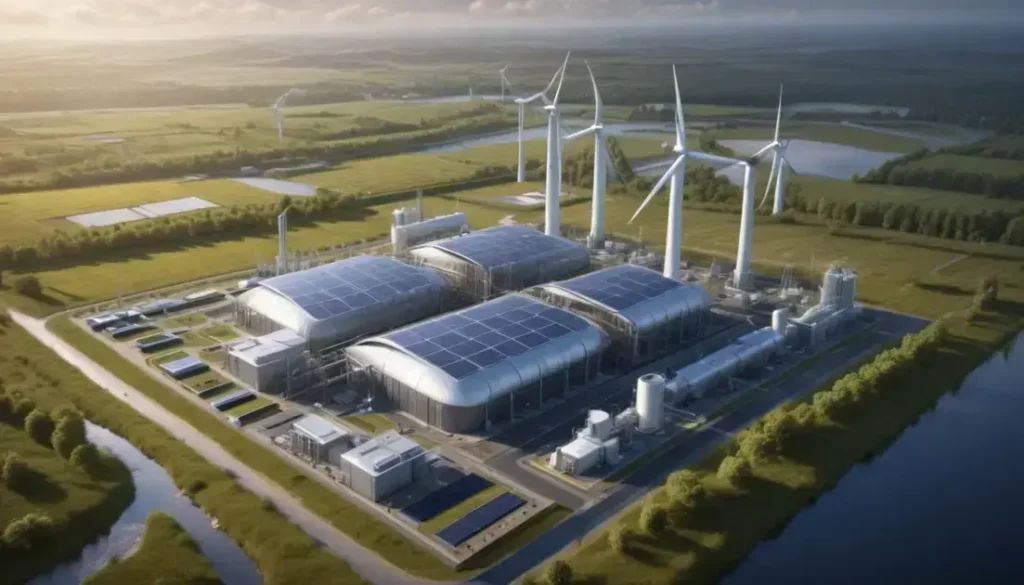The automotive industry is experiencing a significant shift towards electric vehicles due to stringent emissions regulations, necessitating substantial government support and investment in technology to ensure compliance and competitiveness in the evolving market.
In today’s rapidly changing automotive landscape, electric vehicles play a pivotal role. The looming EU emissions regulations are pushing manufacturers to adapt quickly, creating significant implications for businesses.
Stellantis warns of potential factory closures
As Stellantis faces increasing pressure from new emissions regulations imposed by the EU, the Canadian automotive industry is bracing for potential disruptions. The company has publicly stated that factory closures could become a reality if its electric vehicle sales do not meet regulatory targets. This could have serious implications for the Canadian workforce and local economies dependent on these manufacturing plants.
The need to pivot towards electric vehicles is not only a corporate responsibility but also a legal necessity under the evolving regulatory landscape. Stellantis, like many automakers, must adapt quickly to avoid hefty fines associated with non-compliance. This shift to sustainable manufacturing and electric vehicle production is critical for securing future market share.
Furthermore, stakeholders are increasingly concerned about the long-term effects on jobs. A decline in production could lead to significant layoffs, affecting thousands of workers across Canada. To mitigate this situation, collaboration with government bodies for support and incentives is vital for automakers as they transition towards greener technologies.
Impact of EU emissions regulations on automakers
The EU emissions regulations represent a significant shift in how automakers conduct their business. These stringent guidelines are designed to reduce greenhouse gas emissions, mandating that manufacturers increase the production of electric vehicles (EVs) to comply with environmental standards. As a result, automakers are reshaping their strategies to prioritize sustainability while maintaining profitability.
Firms must invest heavily in research and development to innovate and create new EV models. This includes not only enhancing battery technology but also improving vehicle efficiency and performance. Manufacturers who fail to adapt risk severe penalties and loss of market share.
The move towards compliance also influences supply chains, requiring manufacturers to forge new partnerships with suppliers focused on sustainable materials. This shift can lead to increased costs, but it also opens opportunities for those focused on renewable energy and technology advancements.
Moreover, the regulations influence consumer behaviour, pushing many buyers towards environmentally friendly options. As awareness grows about climate change, the demand for electric vehicles is expected to rise. Automakers that align their offerings with these emerging consumer preferences will not only comply with regulations but also strengthen their market positions.
The urgency for increasing electric vehicle sales
The push for the increased sales of electric vehicles (EVs) is critical as governments worldwide tighten regulations on emissions. Automakers are now under immense pressure to adjust their production lines to meet growing consumer demand for eco-friendly alternatives. This urgency is amplified by the fact that government incentives and subsidies for EV purchases are at an all-time high, making electric vehicles more accessible.
Furthermore, automotive manufacturers recognize that aligning their offerings with sustainability goals is not merely beneficial; it’s essential for survival in a competitive market. Companies that delay in ramping up their EV production risk falling behind competitors who are already capitalizing on this trend. This has prompted many brands to develop comprehensive strategies for rolling out new EV models to meet sales targets.
Consumers are increasingly aware of the environmental impact of traditional vehicles, leading to a shift in purchasing behaviour. This cultural change means that automakers must not only produce electric vehicles but also effectively market them to resonate with public sentiments about sustainability.
As automakers navigate this changing landscape, they face challenges related to production capacity, supply chain management, and the need for rapid technology adoption. Meeting these challenges head-on is crucial for establishing a strong foothold in the evolving automotive market.
Consequences of failure to comply with regulations
Failure to comply with emissions regulations can have serious repercussions for automakers. Companies that do not meet the stringent requirements set by governing bodies face hefty fines and penalties, which can significantly impact their financial stability. This risk underscores the importance of proactive compliance measures and presents a pressing need for manufacturers to adapt swiftly.
The consequences extend beyond financial penalties; they can also damage a brand’s reputation. Consumers are increasingly environmentally conscious and may choose to boycott companies that disregard sustainability practices. A negative public image can result in decreased sales and loss of market share, further compounding the financial implications of regulatory non-compliance.
Moreover, automakers that fail to adhere to regulations may be subjected to stricter oversight and scrutiny in the future. This can result in increased costs associated with implementing corrective measures and enhancing compliance protocols. As regulations evolve, companies might also find themselves playing catch-up, which can impede innovation and slow down the launch of new, compliant models.
In the long term, persistent non-compliance can lead to operational disruptions, including factory closures and workforce reductions. Therefore, it is imperative for automakers to prioritize compliance as part of their core business strategy, ensuring they remain competitive in a challenging regulatory environment.
Overview of the current landscape for the automotive industry
The current landscape of the automotive industry is marked by a rapid shift towards sustainability and technology. As governments implement stricter emissions regulations, companies are investing heavily in electric vehicles (EVs) and hybrid models. This pivot not only addresses environmental concerns but also aligns with the changing preferences of consumers who are increasingly prioritizing eco-friendly options.
Furthermore, advancements in technology are reshaping the industry. Innovations such as autonomous driving, connected cars, and advanced manufacturing techniques are becoming integral. These technologies not only enhance vehicle performance but also improve safety features and customer experience. Automakers are now leveraging data to better understand market trends and consumer behaviours, driving product development and marketing strategies.
However, the transition comes with challenges. Supply chain disruptions caused by global events have affected the availability of crucial components, such as batteries for electric vehicles. Additionally, automakers face pressure to balance profitability with sustainability, making strategic planning essential.
Moreover, the competition is intensifying, with traditional manufacturers contending against emerging startups focused solely on EVs. The landscape is evolving swiftly, and only those companies that adapt effectively to these changes will thrive in the future automotive market.
Electric vehicle sales targets and fines
Electric vehicle sales targets have become a critical focus for automakers in light of strict government regulations aimed at reducing carbon emissions. To comply with these regulations, manufacturers must not only increase their electric vehicle (EV) offerings but also achieve specific sales numbers within designated timeframes. Failure to meet these targets can result in substantial fines that can severely impact a company’s finances.
Governments around the world have begun implementing penalties to enforce these standards. The fines are designed to encourage automakers to shift towards sustainable practices by boosting production of zero-emission vehicles. This strategy is not just about fiscal punishment; it’s a step towards promoting environmental responsibility across the industry.
Moreover, meeting sales targets for electric vehicles is essential for maintaining a competitive edge in an increasingly eco-conscious market. Companies that fall short may find themselves not only facing fines but also losing market share to competitors who are successfully meeting these standards. In addition, brands that lead in EV sales can leverage their compliance to enhance their reputation and attract environmentally-aware consumers, establishing themselves as forward-thinking industry leaders.
As automakers navigate this challenging landscape, the focus on achieving EV sales targets and avoiding fines will necessitate innovative strategies and significant investments in technology and marketing.
Future of the automotive supply chain in Canada
The future of the automotive supply chain in Canada is rapidly evolving, primarily influenced by the shift towards electrification and sustainability. As regulations tighten and consumer demand for electric vehicles (EVs) increases, supply chain dynamics are undergoing significant transformation. Companies are re-evaluating their sourcing strategies to include more sustainable materials and components.
With the growing emphasis on reducing carbon footprints, manufacturers are increasingly looking to local suppliers to minimize logistics costs and improve efficiency. This strategy not only enhances sustainability but also strengthens Canadian competitiveness in the global market. By fostering local partnerships, automakers can ensure a more resilient supply chain that is less susceptible to global disruptions.
Additionally, technological advancements are set to play a crucial role in the supply chain’s future. The integration of automation, artificial intelligence, and data analytics will enhance transparency and operational efficiency, allowing for better demand forecasting and inventory management. Companies that invest in these technologies will likely gain a competitive advantage.
Furthermore, collaboration across the industry will be essential for adapting to new technologies and consumer expectations. By working together, stakeholders in the automotive supply chain can navigate the challenges posed by the shift towards electrification and position themselves for long-term success in Canada’s automotive landscape.
How UK regulations mirror EU emissions standards
The regulatory landscape for emissions in the UK is increasingly reflective of the standards set by the EU. As part of its commitment to environmental sustainability, the UK has adopted stringent emissions regulations that align closely with those established by the European Union. This harmonization is crucial as it facilitates trade and ensures that UK manufacturers remain competitive in a global market.
One significant aspect of these regulations includes stringent limits on carbon dioxide emissions from new vehicles. Automakers are required to meet specific emission targets, which have progressively tightened over the years. Similar to the EU, the UK government incentivizes the transition to electric vehicles (EVs) through various schemes, including grants and subsidies that make EVs more accessible to consumers.
Additionally, both regions are implementing monitoring and reporting frameworks to ensure compliance. Regular assessments and penalties for non-compliance serve as motivating factors for manufacturers to adapt their production processes. This alignment reduces the regulatory burden on companies operating across both markets.
The shift towards these stringent emissions standards signals a collective commitment to combating climate change and promoting sustainable automotive practices. As these regulations evolve, it remains essential for automotive stakeholders in both the UK and EU to navigate these changes effectively to thrive in a competitive environment.
Job risks associated with Stellantis operations
The operational shifts at Stellantis due to new emissions regulations pose significant job risks for its workforce. As the company transitions towards producing more electric vehicles, traditional manufacturing roles may be affected, leading to potential layoffs. This restructuring is necessitated by the need to adapt to a changing market while meeting regulatory compliance.
Stellantis has indicated that certain manufacturing plants may face reductions in staffing as production lines are altered to accommodate electric vehicle assembly. Employees in roles heavily focused on conventional internal combustion engines may find themselves at risk of losing their positions. The shift not only impacts direct jobs but also has ripple effects on the supply chain, impacting suppliers and service providers linked to traditional automotive operations.
To mitigate these risks, Stellantis is likely to implement retraining programs aimed at upskilling workers for emerging roles in electric vehicle production and technology. Investing in employee development becomes vital to ensure that existing staff can transition into new positions within the company, alleviating some of the job loss concerns.
Moreover, labor unions and advocacy groups will play a critical role in negotiating terms that protect workers during this transformative period. Fostering open dialogues between management and employees can help create a more resilient workforce prepared to navigate the evolving landscape of the automotive industry.
Investment concerns for Canadian manufacturers
Investment concerns for Canadian manufacturers are intensifying as the automotive industry undergoes a significant transformation. The shift toward electric vehicles (EVs) requires substantial capital investment for new technologies, production facilities, and workforce training. Many manufacturers are assessing their financial strategies to meet the demands of this evolving market.
With stringent emissions regulations and growing consumer preference for sustainable options, Canadian manufacturers must enhance their production capabilities. However, the required upfront investments can be daunting, particularly for smaller firms that may lack the financial resources to compete with larger corporations. These challenges raise questions about their ability to innovate and scale operations in a highly competitive landscape.
Investment concerns are compounded by global supply chain disruptions, which have affected the availability of critical components for electric vehicles. Manufacturers are seeking to secure reliable sources of raw materials, such as batteries and semiconductors, while also addressing rising costs. This situation creates pressure on profit margins, making effective risk management essential.
To navigate these challenges, Canadian manufacturers are encouraged to explore partnerships with government programs and financial institutions that offer support for green initiatives. Collaborative efforts can help mitigate risks and provide the necessary funding to foster innovation, ensuring that manufacturers remain competitive as the industry moves toward a more sustainable future.
Comparative analysis of EU and UK emissions policies
A comparative analysis of the emissions policies in the EU and UK reveals both similarities and differences that could significantly impact the automotive industry. Both regions have established stringent targets for reducing greenhouse gas emissions, with an emphasis on transitioning to electric vehicles (EVs). The EU’s comprehensive framework includes the European Green Deal, aiming for climate neutrality by 2050, while the UK Government has set similar aspirations through its 10-Point Plan for a Green Industrial Revolution.
In terms of regulatory mechanisms, the EU employs a complex system of emissions trading that allows companies to buy and sell carbon credits. This cap-and-trade approach incentivizes reductions where they are most cost-effective. In contrast, the UK has initiated its own Independent Emissions Trading Scheme, which mirrors the EU’s system but operates separately, allowing it to tailor its policies to national priorities.
Both policies also feature substantial penalties for non-compliance, pushing manufacturers to adopt cleaner technologies. However, the UK has introduced measures to support consumers in the transition to EVs, such as grants and infrastructure development for charging stations, which may set it apart from the EU’s broader regulatory focus.
As both regions continue to refine their policies, manufacturers will need to stay agile to navigate the evolving regulatory landscape and leverage opportunities to invest in sustainable technologies.
Calls for government support in the automotive industry
In light of the ongoing transformation within the automotive industry, there are increasing calls for government support to navigate the challenges posed by new emissions regulations and the shift towards electric vehicles (EVs). The transition to sustainable manufacturing practices is essential, yet it requires substantial investment in technology and skills training, which can strain existing resources.
Industry leaders are advocating for financial assistance through grants, subsidies, and tax incentives to encourage the development of electric vehicle infrastructure. These measures can facilitate a smoother transition for manufacturers, allowing them to enhance production capabilities while minimizing the economic burden associated with compliance. Additionally, investment in research and development is crucial for fostering innovation in EV technologies.
Furthermore, establishing collaborative partnerships between the government and private sector can enhance the progress towards sustainability goals. This collaboration can result in shared initiatives focused on improving research, advancing green technologies, and developing a skilled workforce prepared for the demands of the evolving automotive landscape.
Trade organizations and labor unions play a vital role in this process as well, urging policymakers to prioritize the automotive sector in their economic recovery plans. Supporting the industry not only safeguards existing jobs but also helps secure a competitive position for Canadian manufacturers in the global market of electric vehicles.
In Conclusion: Navigating the Future of the Automotive Industry
The automotive industry is undergoing significant changes driven by new emissions regulations and the growing demand for electric vehicles. These shifts present both challenges and opportunities for manufacturers in Canada and beyond.
It is essential for stakeholders, including businesses and governments, to work together. Supportive policies and investments in technology and skills development will help create a more sustainable and competitive industry.
As the landscape continues to evolve, adapting to these changes will be crucial for future success. Embracing innovation, securing government support, and prioritizing environmentally-friendly practices will position the automotive sector for growth and stability in the coming years.
With a collaborative approach, the industry can navigate these challenges and seize new opportunities, ultimately benefiting both the economy and the environment.
Frequently Asked Questions
What are the key challenges facing the automotive industry today?
The automotive industry is currently facing challenges such as transitioning to electric vehicles, complying with new emissions regulations, and managing supply chain disruptions.
How can government support benefit the automotive sector?
Government support can provide financial assistance, grants, and incentives, helping manufacturers invest in technology and infrastructure for electric vehicles.
What role do electric vehicles play in the future of the automotive industry?
Electric vehicles are central to the future of the automotive industry as they align with sustainability goals and meet growing consumer demand for greener transportation alternatives.
Why is collaboration between businesses and government important?
Collaboration is important because it fosters innovation, provides necessary resources, and ensures that all stakeholders are aligned in promoting a sustainable automotive industry.
What should automotive manufacturers focus on to remain competitive?
Manufacturers should focus on investing in advanced technologies, enhancing production capabilities, and embracing environmentally-friendly practices to stay competitive in the evolving market.
How can businesses prepare for the shift towards electric vehicle production?
Businesses can prepare by upskilling their workforce, investing in necessary technologies, and developing partnerships that support sustainable practices in manufacturing.


